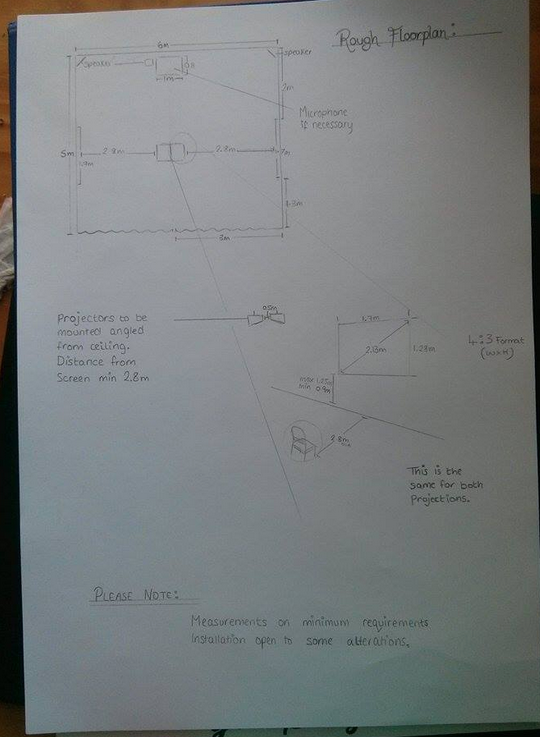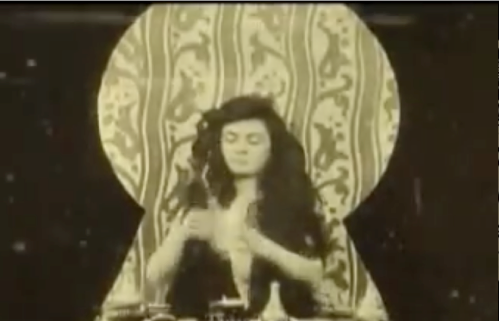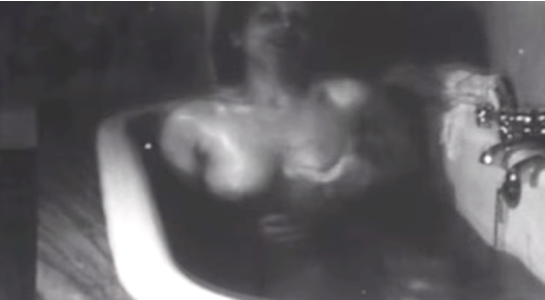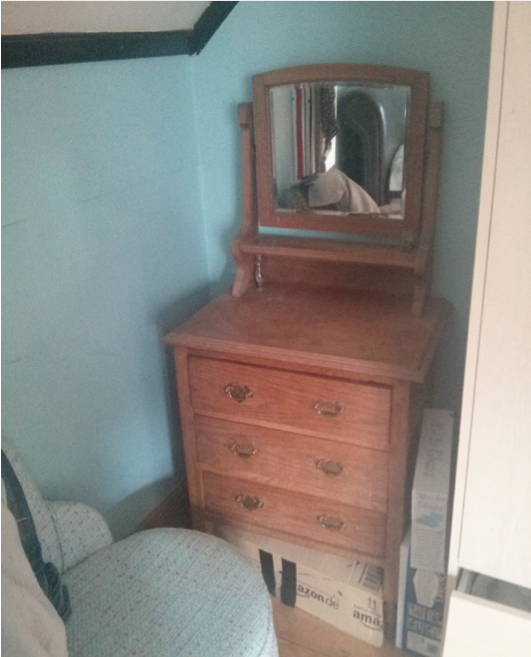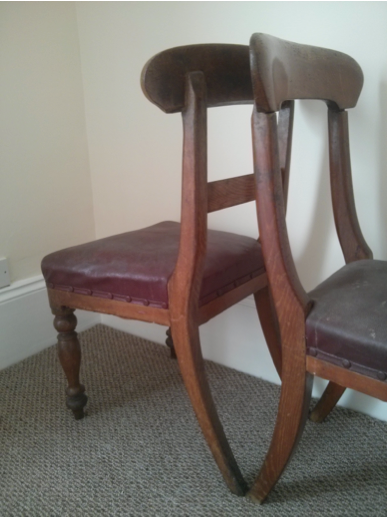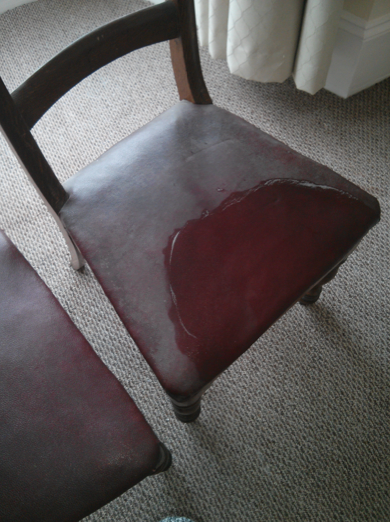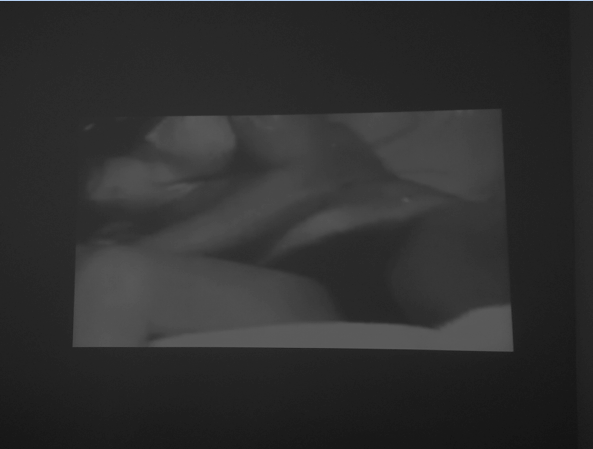This is a photograph of the original drawn floorplan that was included in my portfolio:
Category Archives: Sex, Lies And Videotapes
Video And Text piece
The video piece allows the audience to re-consider the importance of text, and how this can be equally, if not more erotic than the act of viewing sex itself. Some of the earliest forms of pornographic films are dated around the1890’s examples of peeping toms, homosexual acts and stag films. Examples of these include Le Coucher de la Mariée, 1896 and À l’Écu d’or ou la Bonne Auberge, 1910. An example that particularly interests me is The Peeping Tom, 1897; a silent movie which permits the audience to view through the peeping hole at events happening, granting us the field of vision the voyeur possesses.
As pornography developed into the 1920’s further eroticism was present, permitting more nudity within films. It is from this stage that I intend to place the audience.
When considering text and some of the earliest forms of erotica we can look to D.H Lawrence’s Lady Chatterleys Lover, 1928. To which the first edition was banned in the British empire and U.S.A until the late 1960’s as it were previously regarded as an obscene publication, then re-published by Penguin books at the time of the sexual revolution. Is it attributable to the Sexual revolution that the censorship of erotic texts have developed and changed from some of the earliest readable sexual content in Lady Chatterley’s Lover, 1928,to Fifty Shades of Grey, 2011 (suggested to lack the class present in Lawrence’s writing, currently available in any bookstore to pick up and read).
An example of text that particularly interest me from within the first edition of Lady Chatterleys Lover (within the public domain) is:
‘Eh! What it is to touch thee!’ he said, as his finger caressed the delicate, warm, secret skin of her waist and hips. He put his face down and rubbed his cheek against her belly and against her thighs again and again. And again she wondered a little over the soft of rapture it was to him. She did not understand the beauty he found in her, though touch upon her living secret body, almost the ecstasy of beauty. For passion alone is awake to it. And when the passion is dead, or absent, then the magnificent throb of beauty is incomprehensible and even a little despicable; warm, live beauty of contact, so much deeper than the beauty of vision. She felt the glide of his cheek on her thighs and belly and buttocks, and the close brushing of his moustache and his soft thick hair, and her knees began to quivers. Far down in her she felt a new stirring, a new nakedness emerging. And she was half afraid. Half wished he would not caress her so, he was encompassing her somehow, yet she was waiting, waiting.’ (Lawrence,
By appropriating previous material it will permit the audience to realise the development of both text and video’s sexual content from its earliest stages up to the present; questioning the content that is released currently, and whether it holds the same perceived status it did in the past and further examining the truths within erotica, in comparison to the way that much erotic media is fabricated today. This piece will remain silent as homage to early media.
Video Documentation of Performance
This performance questions the development of sexualized objects within contemporary society, and whether or not these have really been accepted. It will further delve into some aspects of ‘the male gaze’ and examine early ideas about women and vanity; referencing John Berger’s theories expressed in his series On the Female Nude, Ways of Seeing, 1972. Within the series Berger speaks about how women from early stages have been almost trained to look at how we perceive one another and how we are therefore expected to perceive ourselves.
Berger discusses how glances act as mirrors, as a reminder of how we should represent ourselves, as ‘behind every glance is a judgment’ (Berger, 1972). He begins by discussing how women were taught, and more importantly expected to survey themselves with regards to men, due to this being the main way to achieve a form of success in life. This stems from early European oil paintings, to which the woman is depicted to be looking back at us spectating her, or for the woman to be gazing at herself within the mirror, symbolizing vanity.(Williams, 2014)
Within our contemporary society more and more woman feel the need to spend copious amount of time on their appearance and constructing their identities ascribable to the pressures of society. The performance begins to break down identity through the use of products, examining the relationship between beauty and sex. This is illustrated by using sexualized beauty products in the form of vibrating mascara’s/lipsticks etc within a woman’s daily routine of presenting herself. The performance will take place in front of a vanity mirror; I am planning to use something similar to in the picture below.
The video itself will be framed through a keyhole as we peer into the scene of a woman within the realm of the being. This evolved from a conversation that took place at an Ann Summers party; to which the representative explained how many of their products have developed into being hidden in the form of another object so their partners would not get jealous of them using sexual stimulants. The sound (vibrations) from this piece, will surround the installation, and throughout the spoken performance.
Marking with 302
Although my Open Call for Bloomberg has been included within my Cura 302 mark, this was only on my reply to my open call. It is for this reason I have included all of my further documentation which was required for the second round of selection for Bloomberg. Further explaining the piece’s and the curation of the installation.
Rocio Boliver
‘Rocio Boliver, a performance artist born in Mexico city in 1956, uses performance as a tool to criticise the ideological expectations that the women who live in Mexico are burdened with. Her performances are a way of her controlling her own life, therefore removing boundaries and fear of losing fragility. Her performances similarly challenge censorship and the forbidden, which permits her to deconstruct her own beauty and strength through the use of pain, sex and other elements within her work.
Boliver feels that this gives her the upper-hand, empowering herself with the ability to disturb and awaken others from the monotony of contemporary society. She regards performance as a safe space whether performed in a gallery, in a street or any public space. A space to express herself without being regarded as non compos mentis, really testing her bodies boundaries whilst draining the mundane from the realm of being. Boliver’s frequent references to sex are simply due to her interest in the iron curtain and expressing the forbidden’s severity. If it weren’t sex that were censored she would investigate something else that was.’ (Williams, 2014)
VestAndPage
VestAndPage formed in 2006 is made up of VErena STenke andANDrea PAGnEs, together Verena and Andrea have been collaborating through the mediums of performance, film, writing and curating. Through their collaboration Andrea was able to explore the expectations of social and personal norms, additionally resonating with Verena’s interest in challenging various conditions of the present. Collectively they produce work that investigates memory and union through pushing their body’s limits through transitory liminal states. It was from my experience of May Day Workshops, with Andrea and Verena I have felt the confidence to push performance within my work.
Installation
The installation itself collates through the three piece’s to address and allow the audience to think about current issues with regards to sex and its development in modern sexual freedom, permitting them to ask is it or has it really been accepted in contemporary society?
The use of both videos within the installation conducts investigations into Laura Mulvey’s theories within Visual Pleasure and Narrative Cinema, 1975, that cinematic separation allows the audience an authentic voyeuristic experience. This can be achieved through the effect of lighting, darkness and shading. This promotes the ideas of exhibitionism and connects the performer/video and the audience to their repressed desires. It is accountable to these ideas and elements of my previous practice that within the installation I only place two chairs back to back for viewing the video pieces on opposite walls. I feel the audience better equip to these undertones when viewed without various distractions.
To enter the space the public will enter through a centre partition in red curtains an insinuation of penetration of the space, soft red light will highlight both the podium where the speech performance will take place and the text pieces will remain following the performance, and softly light the two red leather chairs placed arch to arch imitating the shape of the vulva facing both video projections, projected from above.
Ideas of how the installation come together were informed by Edward Keinholz, Roxys, 1960-61. In which he imitates the room of a prostitution house by using furniture and lighting to emphasis his installation. This helped to inform my decision on the chairs I have selected; worn Edwardian chairs slightly different in form however the broken spring cushions are covered in (wipe clean) red leather (See images bellow).
Example projection of video and text piece (sizing)
Speech Performance:
Speech Performance:
The speech performance will work with fake narrative, exploring the expectations around sex work, inviting the audience to experience and authentic reading of experiences that surround the line of work. The text will be kept anonymous as it is being collected through conversations with the subject. This development came about due to the implications of being unable to work withmany texts as they weren’t within the public domain an example of this is To beg I am ashamed, 1938, Sheila Cousins.
Upon further research there are currently hourly talks occurring on BBC Radio 4 presented by Jenni Murray. Within these discussions Murray has been addressing the issues surrounded by prostitution and whether or not there should be a jail sentence for men who pay for sex. Throughout the week’s morning sessions, Murray interviews various prostitutes with varied experiences and opinions on their present and/or past work, further discussing the separation between prostitution and trafficking.
The spoken durational performances at each venue will allow the audience to further question and examine the issues surrounding sex work and its current position within contemporary society. It is due to the content that will be expatiated that the piece itself will not be for sale, or reproduced after Bloomberg, 2014. However, after the performance, for the duration of the event the text pieces will be left within the installation as a reminiscence of the performance. Lit by the same soft red spotlighting (similarly to those found in darkrooms) that will attract the glare of the public eye through the performance on the opening night.
Censorship
Censorship:
‘It is arguable that censorship within the art world will cradle people from elements in society that they haven’t had the chance to perceive their own understanding of. With regards to sexual context in art it seems questionable to constrict what is shown due to the accessibility of this society.’ (Williams, 2014)
‘It could be argued that just as people have the right and freedom to not look at pornography on the Internet, people have the choice to not view works they deem harmful to their personal attitudes.’ (Williams, 2014) These ideas have recently been raised within the BBC documentary Porn: What’s the Harm, 2014, statistics claimed from a survey of 1000 subjects 7% had viewed porn on the internet from the age of 10 or younger. In comparison to this the acceptance of both the nude and sexuality within the gallery environment allows the audience to similarly decide for themselves whether or not to connect with the piece.
There are various examples of artists who use censorship to strengthen their concepts and example of this is Vito Acconci’s Seedbed, 1972. By removing himself from the act of masturbating within the gallery space and placing himself underneath the floor, he forces the audience to become a sexual object becoming part of his own sexual fantasy.
‘However, censorship itself is paramount when used as a tool within artistic practice. By Censoring we are able to draw attention to certain elements instead of removing these all together; inadvertently emphasising the contrary. This can be achieved through selection, hiding or removing e.g An example of this is Sous Rature, Jacques Derrida.’ (Williams, 2014)
Title
Title:
The title of the installation is an appropriation of the 1989 film Sex, Lies and Videotape. The film, similarly to the installation questions the context of viewing for spectatorship with regards to voyeurism, and how this can be implicated through the audience’s experience (permitting them to take on the role of the ‘voyeur’). Within the film Steven Soderbergh creates anexploration into the regulations of intimacy and trust when considering communication of our sexual preferences. Soderbergh also investigates the way some people regard the issues around sexual activity or masturbation and how we censor ourselves and the confidentiality of this content (otherwise being regarded as an extrovert).
